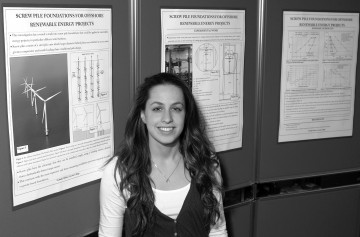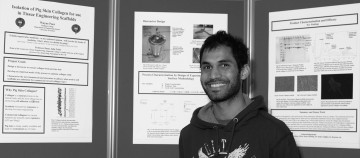| Issue 9 |
This is the tenth year in which the Society has organised an exhibition of fourth-year projects in Trinity Term. Over that period we have had 169 entries, of which 109 won prizes. If we list them by colleges, St John's comes out in the lead with 11 prizewinners, closely followed by Lincoln with nine. The contest is judged by a group of former undergraduates, four of them usually, from about 5-15 years back, now engineers in the "real world", who seem to enjoy coming back to do this. This year they were:
Gareth Jones, Balliol 1995-9, now with Strainstall
Manish Pindoria, Pembroke 2001-5, now with Sony Broadcast and Professional
Jonathan Rhodes-James, Brasenose 1991-5, now with Arup
Lynsey Thomas, Balliol 1995-9, now a telecommunications consultant
The prize money this year amounted to £2500 in total, sponsored by Atkins and GlaxoSmithKline (well-established regulars) and Sony BPRL (a new one this year). We are very grateful both to the firms for the sponsorship and to the alumni working for them through whose initiative the sponsorship is generated.

|
The £500 Atkins Prize for an exhibit in the civil/structural field went to Nathalie Hakim of Lincoln (above), describing a study of a new way of fixing off-shore windmills to the sea-bed. The large horizontal force on a windmill means that a foundation pile on the windward side can be in tension, and therefore apt to lift. Nathalie's model used 25 mm diameter piles with 100 mm diameter helically-shaped flanges which "screwed" into the soil when rotated about their axes. They therefore carried tensile force more as a screw does than a nail. Tests on dry sand 900 mm deep showed results much as expected, except that the torque needed to screw the pile in did not increase with depth as much as predicted. What difference does it make if the sand is wet? And the writer wondered if further inspiration might be got from that type of Rawlplug used to fasten bathroom cupboards to plasterboard walls!

|
The £300 Sony Prize, for an exhibit relating to image, video or audio processing, was awarded to Toby Miller of Keble (above), for "A lot of handwaving - fast human upper-body pose detection". This used existing software to find a face, and then looked for other areas of the same skin colour, and assumed they were hands.

|
The judges awarded £400 prizes both for the best "poster-only" exhibit and for the best one involving hardware. Both were awarded to exhibits in the bio-engineering field. The former went to Wayne Paes of Wadham (above) for "Isolation of pig skin collagen for use in tissue scaffolds". Collagen is a natural protein in humans, and is used in regenerative medicine to promote cell adhesion and growth. It has, surprisingly, been extracted from rat tails, but pig skin is a cheap and readily obtainable alternative, with some technical advantages. The project was concerned with scaling up to bio-reactor size an extraction process already tried in a beaker, using pepsin and lactic acid. The variation of yield was plotted as a function of pepsin level and residence time.

|
The "best hardware" prize went to Chris Wilkinson of Lincoln for a 3-D ultrasound tomography scanner (above). The transmission of ultrasound through the specimen had to be plotted as the transducers were moved horizontally past it, and repeated for different azimuthal orientations of the specimen. Computer analysis of this data could map a cross-section of a horizontal slice, and the sequence would then be repeated at different heights. So the transducers had to be movable both horizontally and vertically, and the specimen rotated in azimuth. This was done with stepper motors and belt drives driving a multplicity of lead screws. All the moving parts (except the motors) had to operate under water and contain no metal. We did not see it in operation, but the design seemed very elegant.
Five further prizes were awarded, making nine in total, out of the eighteen who entered, to:
Ian Horn, Christ Church, for "A high resolution micro-indentation device for testing the stiffness of biological tissue";
Nennia Orji, St John's, for "Can we detect a stroke before it occurs?";
Peter Charlton, Hertford, for "Demonstrating elastic stability theory";
Ben Harland, New College, for "Solitary wave interactions in the open ocean";
Ben Kirollos, University, for "How do you solve a problem like cooling a jet engine?"
The nine other entrants offered exhibits on a wide variety of topics, ranging from "rainwater harvesting for disaster relief", through "the dynamics of bell towers", to "the dynamics of shaken-baby syndrome". This last was one of the eight exhibits in total that related to some aspect of bio-engineering, an area of rapidly growing popularity in the Department.
| << Previous article | Contents | Next article >> |
| SOUE News Home |
Copyright © 2010 Society of Oxford University Engineers |
SOUE Home |